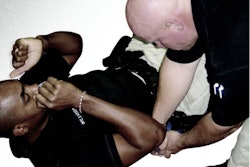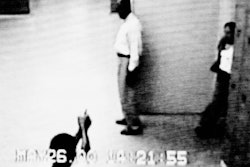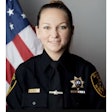When Derek Brinkman was born in January 1985, his father, Doug Brinkman, couldn’t believe his good fortune. He passed out cigars and received many slaps on the back.
Unfortunately, his joy and love of family wasn’t contagious. Just a few days after the birth of his son, Brinkman found himself back on patrol with the Sauk Rapids (Minn.) Police Department, responding to a domestic violence call.
Broken Glass
Brinkman and his two assisting officers, James McMahon and Arthur Daniels, were dispatched to a stabbing call. Moments earlier, an informant had advised that his neighbor had been stabbed by her ex-boyfriend who had also threatened the informant with a kitchen knife.
The informant had prudently defended himself by striking the suspect over the head with a ratchet before retreating to his own house to call the police.
Local officers knew the house. Escalating conflicts at the location had required police to seize firearms from the house only a week before. The suspect had since adapted, taking up a weapon that was just as lethal: a kitchen knife.
Parking in an alley behind the house, the three officers made a quiet approach to the back door. Shards of glass dangled tenuously from the door’s window frame, offering evidence of the conflict that had already taken place and providing the officers with the sights and sounds of the violence that continued therein.
Blood on the Floor
The walls, doors, and furniture were awash with blood, and the floor was soaked with it. It wasn’t just the victim’s blood, either. Peering through the window, the trio of officers found the suspect seated just inside the door, blood seeping from his stomach where he’d stabbed himself.
Brinkman and his fellow officers attempted to speak with the wild-eyed man through the broken window. But there’s no using the voice of reason on people who are emotionally deaf. His only response was to spring from the floor and swing the knife wildly in their direction.
Fortunately, the officers had positioned themselves out of slashing range.
But the woman was in very real danger. She cowered in the corner, begging for her life.
The man appeared to be as impervious to her pleas as he was to the blood seeping from his torn belly. He stalked her, taunted her, and called her names, pausing occasionally to scream at the officers at the windows.
The officers were convinced that they were dealing with a man who was crazed by some kind of stimulant. He howled, he screamed, the knife in his hand flashed out at his terrified former girlfriend.
Making a Plan
It was a traumatic scene in every sense of the word. The officers considered their options. The front and back doors were locked, and a window entry was out of the question.
Another door, one not normally used, offered the best opportunity to get inside. But that would mean breaching the plastic sheeting that covered it and that might make a lot of noise.
A plan was formulated. McMahon and Daniels would engage the suspect verbally at the back of the house in an attempt to keep him distracted while Brinkman worked his way into the residence via the insulated door.
Inside, the suspect continued his pursuit of the bloodied woman from room to room.
From their position outside of the house, they didn’t have a shot. The suspect exhibited an uncanny knack for positioning himself so that the victim was always in the line of fire.
The only deterrent McMahon and Daniels could use from outside the house was to yell at the suspect each time he narrowed the gap between himself and the woman. Periodically, the man would even rush at the broken window in an attempt to slash at the officers.
While McMahon and Daniels did what they could to command the man’s attentions, Brinkman holstered his weapon and went to work on the unused and sealed door. As quickly and as quietly as possible, Brinkman tore away sections of the plastic sheeting that the homeowner had mounted on the door to keep out the winter weather. When he’d removed enough to accommodate his entry, he advised his fellow officers that he was going to make his move.
Double Tap
If Brinkman could insinuate himself between the victim and the suspect, give the attacker something else to fixate on, he thought he might be able to calm the man down. Brinkman re-drew his weapon from his holster, planted one foot through the doorway, steadied his balance, and then followed through with his back leg.
That’s when it happened.
The woman was suddenly 15 feet in front of Brinkman, running from left to right across his field of vision. It appeared that she was cradling a child in her arms and trying to get from the kitchen to an open bedroom door. The suspect—oblivious to Brinkman’s presence in the room—bore down on the woman, knives slashing.
Brinkman had two thoughts, almost simultaneously. First, he knew there was no way he could close the gap between himself and the suspect before the man could get into the room and kill the woman. Second, if he hesitated, the angle of Brinkman’s line of fire would change, thereby placing the woman in greater jeopardy. Brinkman aimed his Smith & Wesson .357 revolver at the slashing blur and pulled the trigger.
Brinkman fired a textbook double-tap, one shot quickly followed by another. He saw one hit the suspect in the upper torso. The suspect’s momentum caused him to stagger a couple of steps before he collapsed at the open doorway to the bedroom where the woman and her terrified son had sought refuge.
At the sound of the shots, Brinkman’s partners kicked in the back door and rushed into the house. McMahon kicked two knives from the suspect’s hands; then he and Daniels initiated CPR.
Despite the best efforts of the officers and paramedics, the man was pronounced dead minutes later at a local hospital. One round had entered the right side of his chest and exited the opposite side. The other round had skimmed the suspect’s back and pierced an ironing board before striking the opposing wall and whirling back, where it landed near Brinkman’s feet.
The Waiting
Following the officer-involved shooting, the Sauk Rapids Police Department was obligated to remain tight-lipped until a grand jury convened and rendered its findings.
Finding the police less than forthcoming and left to his own devices and speculations, a rookie reporter for the local daily paper, the St. Cloud Times, spun the story to insinuate that officers had acted precipitously, escalating an event that might have been resolved otherwise.
Meanwhile, the coroner’s office released its report. A round from Brinkman’s gun had perforated the suspect’s lungs and heart, causing massive internal trauma. The coroner also concluded that while the man had been drinking, there were no drugs present in his system.
What the officers had found themselves up against at the house was high-octane rage. What they found themselves up against in the aftermath was second guessing and Monday morning quarterbacking.
Officers from nearby agencies offered their own various takes on the shooting. Most were supportive and empathetic. But not all.
One officer chimed in with the Times, finding that the officers had precipitated the shooting; others more magnanimously characterized it as a “suicide by cop.”
Brinkman found neither characterization appropriate. The former opinion presumed that the officers possessed a window of opportunity to deploy lesser force to incapacitate the suspect. The latter did not do justice to the dangers inherent to the situation. In his heart, Brinkman knew that the man he’d killed had been oblivious to the danger that he had created for himself in attempting to take the life of another.
“I dealt with the shooting badly,” Brinkman admits. “Back then, we didn’t have the kind of psychological support services that are routinely in place now. I went to one debriefing with the St. Paul shooting team. Whenever I would hear of other officer-involved shootings, I would immediately re-immerse myself in mine. I’d feel the palpitations…start sweating.”
Even the time spent with his newborn son would find Doug Brinkman revisiting the fact that he’d killed a man…someone else’s son.
He sought distraction elsewhere. “I drank,” he says. “I’d started down a bad road, but got myself off of it quickly. It helped that once the facts were presented to the grand jury, it only took them about 15 minutes to find the shooting justified. And that started the closure. But the real closure came from the girl’s mother, who thanked me for saving her daughter and her grandson.”
Perhaps the birth of Officer Doug Brinkman’s son only bolstered his commitment to save the life of the woman’s boy on that January evening. Doug has come a long way since then.
And so has his son.
Today Derek Brinkman is a Benton County (Minn.) Sheriff’s deputy.
Dean Scoville is a patrol supervisor with the Los Angeles County Sheriff’s Department and a contributing editor to Police.
Shots Fired: Sauk Rapids, Minnesota 01/09/1985
When Derek Brinkman was born in January 1985, his father, Doug Brinkman, couldn’t believe his good fortune. He passed out cigars and received many slaps on the back.













